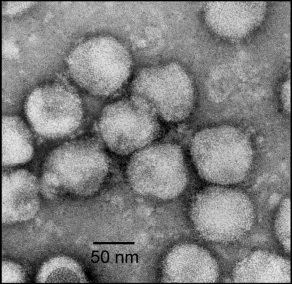Nidovirales facts for kids
Quick facts for kids Nidovirales |
|
|---|---|
 |
|
| Electron micrograph of virus particles | |
| Virus classification |
|
| (unranked): | Virus |
| Phylum: | incertae sedis |
| Class: | incertae sedis |
| Order: | Nidovirales |
Nidovirales is a large group, or order, of viruses. These tiny germs can infect both animals and humans. This important group includes several well-known virus families, such as Coronaviridae, Arteriviridae, Roniviridae, and Mesoniviridae.
The name Nidovirales comes from the Latin word nidus, which means "nest". This name was chosen because all viruses in this group create a special "nest" of genetic material inside the cells they infect. This "nest" helps them make more copies of themselves.
Contents
What are Nidoviruses?
Nidoviruses are a special kind of RNA virus. This means their genetic information is stored in RNA instead of DNA. They are also "enveloped," which means they have a protective outer layer, like a tiny bubble, around their core. This envelope helps them enter and exit host cells.
These viruses are known for having very large genomes (their complete set of genetic instructions). This large genome allows them to carry out many complex tasks inside the cells they infect.
Families of Nidoviruses
The order Nidovirales is divided into several families. Each family contains different types of viruses that share similar features.
This family includes the well-known coronaviruses. These viruses can cause respiratory (breathing) and intestinal (gut) illnesses in both animals and humans. Some coronaviruses, like those that cause the common cold, are mild. Others, like SARS-CoV-2 (which causes COVID-19), can cause more serious diseases.
Arteriviridae
Viruses in the Arteriviridae family mainly infect animals. For example, they can cause diseases in pigs, horses, and monkeys. These viruses often target immune cells, which are important for fighting off infections.
Roniviridae
The Roniviridae family includes viruses that infect crustaceans, such as shrimp. These viruses can cause serious diseases in shrimp farms, leading to economic losses.
Mesoniviridae
This family contains viruses that are often found in insects, especially mosquitoes. Scientists are still learning a lot about these viruses and their effects.
How Nidoviruses Work
When a nidovirus infects a cell, it uses the cell's machinery to make copies of itself. A key part of this process is how they create their "nested" set of genetic messages (called subgenomic mRNAs). Imagine a set of Russian nesting dolls; each doll fits inside a larger one. Nidoviruses create genetic messages that are like these dolls, with smaller messages nested within larger ones. This unique method helps the virus produce all the proteins it needs to survive and multiply.
Understanding how nidoviruses work is very important for developing ways to prevent and treat the diseases they cause in both animals and humans.
Images for kids
See also
 In Spanish: Nidovirales para niños
In Spanish: Nidovirales para niños


